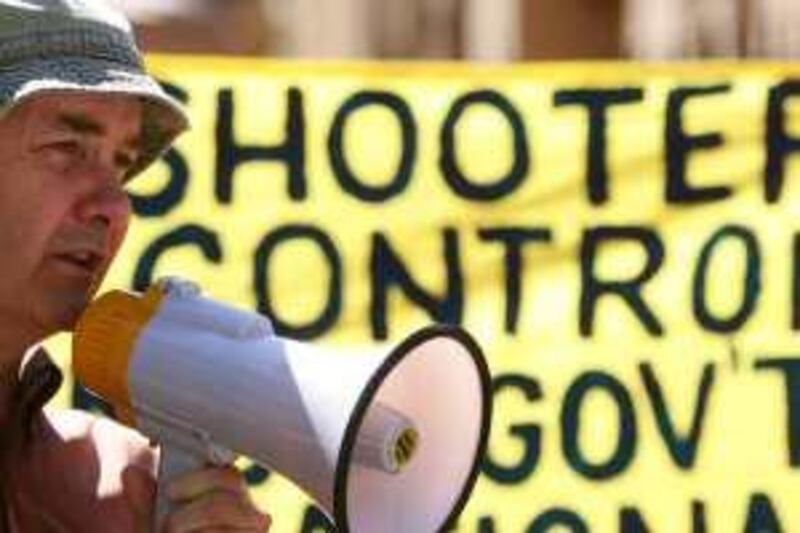SYDNEY // Plans to allow hunting in some of Australia's most pristine national parks have stunned conservation groups. The proposals have been drawn up by the Shooters Party in the New South Wales state parliament, which believes that an army of recreational hunters should be unleashed against a plague of feral pests, including rabbits and foxes, that have infested vast areas of protected wilderness.
As it stands, the law sanctions blood sports in selected parts of state forests but under an amendment such pursuits would be permitted in some of south-eastern Australia's most prized countryside. "At first we did think it was a joke," said Carol Booth, a policy officer with the Invasive Species Council, a non-profit environmental organisation based in Victoria that campaigns for laws to protect native wildlife. "The bill will extend hunters' rights to hunt into national parks and will also allow them to hunt certain native species, including black swans and kangaroos."
Ms Booth has argued that amateur marksmen were not an effective solution to the rampant spread of vermin that began when European settlers brought an array of animals to Australia. "When you open up public lands for hunting you create the incentive for hunters to spread feral animals around in order to create new hunting opportunities. We've seen this particularly with deer and pigs," she added. "One of Australia's biggest challenges is to effectively manage feral animals."
Campaigners believe that a range of co-ordinated measures are required and have cited the recent culling of wild pigs west of Sydney, where professional sharpshooters in helicopters eradicated 8,000 animals in a concerted eight-month operation, while during the same period, part-time enthusiasts killed about 1,000. New biological controls are also being investigated to try to put serious dents into the populations of introduced species, including wild dogs and goats, which have inflicted immense damage on agriculture and Australia's fragile environment.
Pathogens have been used to good effect in the past. The myxomatosis virus released in Australia in 1950 initially reduced rabbit numbers by up to 99 per cent and more advanced biochemical defences are being developed. The Shooters Party's proposition also includes provisions for the establishment of private game reserves, where operators would be authorised to release several exotic bird species for their clients to kill.
"We've had a story of one hunter who has been buying up black buck antelope from a zoo in the hope that in the future he would be allowed to have these in a game reserve and have hunters shoot them. You could get all sorts of African animals being released into these reserves," said Ms Booth. The contentious legislation is being championed by Robert Brown, who sits in the New South Wales upper house of parliament where he represents the Shooters Party, which draws support from gun enthusiasts, fishermen, foresters and farmers. While it boasts just two MPs, the minor party has been able to punch well above its parliamentary weight because its backing is critical to a beleaguered state government in a hostile upper chamber.
This political influence has given Mr Brown optimism that the controversial national park reforms will be approved. There is also an insistence that recreational hunters can play a decisive role in Australia's Herculean battle against marauding pests, with claims weekend warriors slaughter about 30,000 animals each year. "Whilst that is a drop in the bucket of the millions of feral animals that exist in Australia, within public lands we argue that it is at least as effective as the other methods they [the authorities] use. Certainly it [recreational shooting] should not be discounted.
"We are confident that good science will triumph in the end and that we will be able to extend this [hunting] programme from the two million hectares of state forests into the six-million-plus hectares of national parks within New South Wales," said Mr Brown, who argued that rangers' use of toxins to kill foxes and wild dogs also threatened vulnerable native creatures. "1080 is a very nasty poison and kilogrammes of this stuff are used throughout the state. The trouble is it is not target-specific. In other words you don't know if you've poisoned a fox or a dingo or indeed whether you've poisoned one of our native animals, like quolls, eagles or lizards," Mr Brown added.
Conservationists remain unconvinced and also are worried about suggestions that state officials will endorse revenue-raising plans to build luxury lodges and cabins in national parks, which have been established over the last 150 years. "Development would pick the eyes out of these key sites. The most popular and attractive areas would get developed and they are overtaken by these elite facilities. That is just not the way a park should be managed," said Keith Muir, director of the Colong Foundation for Wilderness.
"This is a wonderful heritage that we have to protect forever for future generations," he explained during a small but noisy protest outside the New South Wales parliament in Sydney. "If you develop the parks you defeat the very purpose of setting them aside in the first place," said Mr Muir. foreign.desk@thenational.ae





